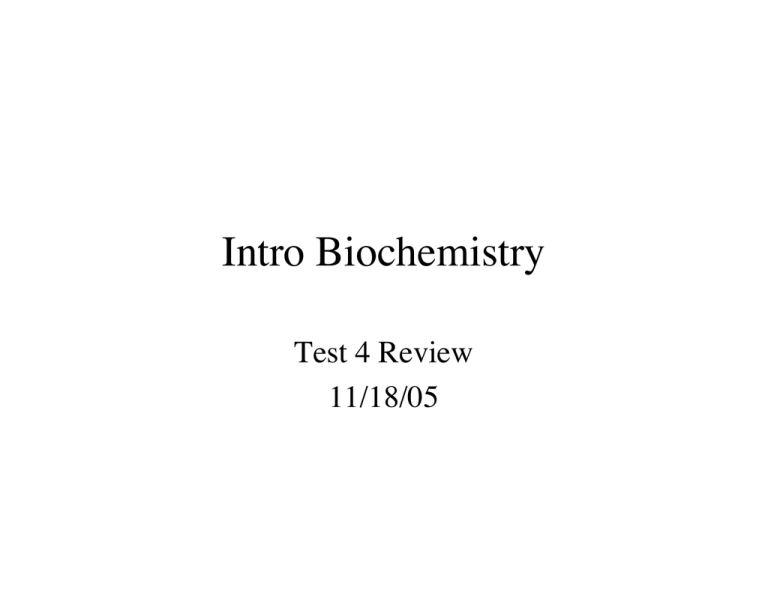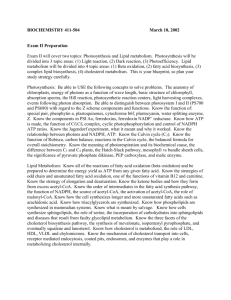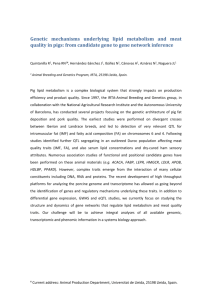Intro Biochemistry Test 4 Review 11/18/05
advertisement

Intro Biochemistry Test 4 Review 11/18/05 Chapter 17 • • • • Meaning of oxidation and reduction Source of reducing equivalents Flow of electrons through electron transport chain Know the two paths -- starting with either Complex I or Complex II • Understand how the electron transport chain is coupled to oxidative phosphorylation • Know how proton gradient is used to generate ATP via chemiosmotic model (the accepted model) • Know how cytoplasmic NADH sends electrons to mitochondria Lipids Ch 8 • • • • • • • • Lipid structure and properties Triacylglycerol function Triacylglycerol breakdown Adipocyte function Glycerophospholipid function and properties Sphingophospholipid function and properties Cholesterol structure and function Cholesterol precursors Lipids Ch 9 • • • • • • Micelle vs. Lipid bilayer Lipid bilayer function Lipid bilayer composition - general Fluid mosaic model Membrane proteins Membrane transport - passive, active Lipid Metabolism Ch 18 • Dietary Triacylglycerols – – – – – breakdown emulsification absorption Transport in blood Storage and utilization Lipid Metabolism Chapter 18 • Hormonal regulation of triacylglycerol breakdown – – – – – – Triggered by blood glucose Release pancreatic hormones Binds to cell receptors Triggers cAMP production Activates enzyme Releases FA and transport into blood Lipid Metabolism Chapter 18 • Fatty Acid Catabolism – – – – Activation Transport Steps in breakdown Energy yield (itemized) • Odd Chain Fatty Acid Catabolism – Products – Propionyl CoA changed to Succinyl CoA Lipid Metabolism Chapter 18 • Fatty Acid biosynthesis – – – – – – Shuttle for Acetyl CoA Rate-determining step and modulators Importance of malonyl CoA Unique cofactors - ACP Steps of biosynthesis Product • Be able to compare FA breakdown and synthesis and know how they are regulated Lipid Metabolism Chapter 18 • Cholesterol – – – – – Importance Function and Properties Transport of Steroid precursor Excretion of (as bile salts) Lipid Metabolism Chapter 18 • Cholesterol biosynthesis – Precursors – Rate-determining step and regulation • Lipoprotein complexes and Chl – – – – VLDL: liver to tissue LDL: major Chl carrier HDL: tissue to liver Chilomycrons: for exogenous lipids and exogenous Chl • Cholesterol acquisition by cells – Receptors – Chl ester breakdown and Chl release Nitrogen Metabolism Chapter 19 • Nitrogen processing in animals – – – – – Glutamate formation Glutamine formation Aspartate formation Alanine formation Know reactions for all the above Nitrogen Metabolism Chapter 19 • Essential vs. Non-essential amino acids • Amino acid breakdown – – – – Deamination Degradation of !-keto acid Glucogenic and/or ketogenic products (on final exam) Tie in to Citric acid cycle Structure of Human Plasma Lipoproteins phospholipid cholesterol Apoprotein cholesteryl ester triacylglycerol Chylomicron LDL Properties of Apoproteins LCAT = lecithin:cholesterol acyl transferase LPL = lipoprotein lipase • Apoproteins are amphipathic helices. Charged amino acids on one side of !helix and neutral amino acids on the other. (Neutral side interacts with lipid)



